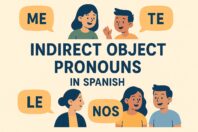Usted vs Tú: Easy rules and tips for how to say “You” in Spanish

Get our free email course, Shortcut to Conversational.
Have conversations faster, understand people when they speak fast, and other tested tips to learn faster.
More infoIf you’re new to the language, it’s easy to see how usted vs tú in Spanish may cause some confusion: both words are used to address a single person as you. They each have specific rules for when and how they’re used, so it’s important to choose the right one.
In simple terms, there are two basic rules that explain the difference between tú and usted:
- Rule 1. Tú is informal, while usted is more formal
- Rule 2. Tú has its own conjugation, while usted uses third-person conjugations like él and ella
If you remember the first rule about formality, you’ll choose the right word between tú and usted nearly every time. The second rule about conjugation takes more practice, but once you’ve grasped it you’ll be using these words the right way every time.
In today’s post we’ll cover the nuances of usted vs tú in Spanish. We’ll cover exactly when and how to use each one, starting with levels of formality and then getting into their grammar rules.
We should also mention that the English subject pronoun you has several other translations in Spanish, with tú and usted only used in singular to address one person. For a comprehensive lesson on every option, please see our post on tú vs usted vs vosotros vs ustedes.
Tú vs Usted in Spanish: Formality
The most important difference between usted and tú is their levels of formality. You don’t really have this distinction in English since you address anyone as you, whether you’re talking to a child, to an elder, to a client, or even to the president. Many languages, such as French with tu vs vous, exhibit important levels of politeness through their you pronouns. In Spanish, we do this with tú vs usted.
In Spanish, tú is known as the familiar or informal you, while usted is the polite or formal you.
If you choose to use tú with someone, it’s a way to demonstrate that you feel a level of comfort or even camaraderie with that person, whereas choosing to use usted introduces a greater level of protocol or respect. So when do you use tú vs usted in Spanish?
Let’s see the main factors to consider when choosing to use one over the other. Keep in mind that several of these remain fairly subjective, so there are often contexts where either one can work just fine. And if you’re a beginner Spanish student you’ll also have a degree of flexibility, since locals will understand that you aren’t speaking your native language!
When to use Tú
Let’s start with the informal you in Spanish, tú. The verb to describe the act of addressing someone with tú is tutear, while tuteo is the name for this informal form of address. Don’t forget to include the accent mark to differentiate between tú vs tu, since the unaccented tu is the possessive adjective meaning your.
So who should you tutear?
1. When there is a relationship of trust between people.
It’s very normal to use tú when we talk with friends, family, classmates, and so on. Couples use tú with each other, as do coworkers who see each other all the time.
2. To talk with children.
You should always use tú in Spanish when talking with kids, and also try to use simple vocabulary.
3. Between people who appear to be a similar age, even when they don’t know each other.
It’s quite common for strangers to address each other as tú when there’s a perception of being social peers in the same age range or younger, which has an added element of breaking down barriers. This is a normal instance of tutear practiced when interacting with a person on the street you stop to ask for directions, another participant at an event or party, or someone you meet at a bar, while it’s sometimes also used between same-age peers in interactions with hotel receptionists, waiters and waitresses, salespeople, and so on.
When to use Usted
Usted is the formal you in Spanish, used whenever we need a polite form of addressing someone. Ustedear is the verb for addressing someone with usted in Spanish. While we saw that it’s often fine to use tú among people of the same age, there are some important exceptions where you should definitely opt for usted.
So when do you use usted in Spanish?
1. To talk with older people.
In Spanish-speaking cultures, respect is shown to elders by always addressing them using usted. Don’t take this the wrong way if someone uses usted with you and you’re not exactly “old,” since it’s really a matter of being “older” than the speaker. If you’re in your 20s, for instance, you should systematically be using usted with anyone who appears to be in their 40s or older. Even among friends or family, it’s very common to use usted with your friends’ parents or grandparents, or even with your in-laws.
2. To address anyone you would call señor or señora.
These are the Spanish equivalents of sir and ma’am, while they’re also used in place of the formal titles of Mr., Ms., and Mrs. If you normally use any of these with someone, you should definitely also usteadar them.
3. When talking to your boss or anyone above you in a work hierarchy.
Whenever you speak with a colleague who has a higher rank within the company, especially your boss, it’s important to use usted as a sign of respect. They will probably use usted with you too, as it maintains a level of formality and distance between you. This is in contrast with your coworkers who you can consider peers and address with tú.
4. To talk with anyone in a position of authority.
If you’re speaking to a border guard, a police officer, a judge, or even a security guard or a civil servant, you should always demonstrate some deference by using the formal you. In school contexts, this applies to your teachers, professors, and administrators. Addressing any of these authority figures with the friendly tú form is a blatant gesture of disrespect that risks backfiring on you!
When to use Usted vs Tú
Most of these rules on the difference between usted and tú are pretty straightforward. If you’re talking with your family or with children, you use tú. With elders or with anyone where you need to demonstrate a sense of social hierarchy, you use usted. Easy, right?
But what about that big gray zone of people who might be your peers? We saw how it’s common enough for people to tutear each other in a lot of in-between contexts, so in such circumstances, when do you use usted in Spanish rather than tú?
The reality is that there’s really a lot of variation in how people choose to apply different standards between tú and usted. It often comes down to regional differences, local norms, or even just how much distance is intended between the two speakers. Tú is good for keeping things informal and close, while usted is more formal and creates a level of distance.
This distance can be added intentionally, even where usted may not be the default. If you overhear your friend speaking emphatically with his father and he suddenly switches to using usted, for example, they’re probably having an argument and the added formality is intended to put some distance between them. If you’re at a party and address a particularly attractive person as tú, on the other hand, their significant other may take offence at the level of familiarity you’re suggesting by not using usted.
As you can see, tutear can be used to insert a level of familiarity, even if it doesn’t necessarily exist. If a shopkeeper starts acting friendly and calls you tú, perhaps it’s because they want you to feel comfortable and buy something. You might do the same though, using the friendly tú as part of your bargaining tactic!
Usted is often the safest bet if you’re unsure, especially where you don’t know someone. In some cultures it can even be common for people to stick with usted with people they know, only moving on to tú once they decide that they’re really friends.
At the end of the day, whether to use usted vs tú in Spanish is all about what the two people feel comfortable with. If you’re unsure you can just ask. And don’t be surprised if, once you first ustedar someone, they instead tell you it’s ok to tutear them!
Grammar: Conjugating with Tú vs Usted
Now that we’ve covered the main differences in formality between tú vs usted, we’re ready to explore the key grammatical differences: tú has its own set of second-person conjugations just like you in English, whereas usted requires the use of third-person conjugations, like he, she, and it in English.
This means that usted in Spanish takes the same conjugations as él and ella, and is treated as a third-person pronoun in Spanish grammar. This treatment as a third-person singular pronoun applies across the different categories of personal pronouns, so if usted is a sentence’s subject then its corresponding reflexive or object pronouns need to match.
Here are the various forms of both tú and usted when they appear in different parts of a sentence, with links to our full lessons about each category of Spanish personal pronouns:
| Subject pronoun | Reflexive pronoun | Direct object pronoun | Indirect object pronoun |
| tú | te | te | te |
| él, ella, usted | se | lo, la | le |
Let’s sum up this first rule of tú vs usted:
- Tú acts as a second-person singular pronoun
- Usted acts as a third-person singular pronoun
This same rule applies to other grammatical categories such as possessive adjectives or possessive pronouns. For example, your in Spanish is tu or tus for tú, whereas for usted it’s su or sus.
Conjugating Tú vs Usted
Now that the rules are clear, we’re ready to explore the difference between usted and tú conjugations.
Let’s start by seeing how a few of the most important Spanish verbs are conjugated with both. Click through to see all the conjugations of each verb, along with explanations of their nuances. We’re including the yo conjugations of each verb for good measure, since you likely already know those. Here are each of their first-, second-, and third-person singular conjugations in the simple present tense:
| Verb: Spanish – English | yo conjugation (first-person) | tú conjugation (second-person) | usted, él, ella conjugation (third-person) |
| ser – to be | soy | eres | es |
| estar – to be | estoy | estás | está |
| tener – to have | tengo | tienes | tiene |
| hacer – to do, to make | hago | haces | hace |
| ir – to go | voy | vas | va |
| querer – to want | quiero | quieres | quiere |
| deber – to have to, must | debo | debes | debe |
| poder – to be able to | puedo | puedes | puede |
| poner – to put, to place | pongo | pones | pone |
Do you see the important difference between tú and usted conjugations in the present tense? With tú, the conjugated verb ends in -s, while the conjugation usually ends in a vowel with usted.
Example sentences using Tú
Now that we’ve seen the conjugations and the pronouns associated with tú, let’s see them in action with a bunch of example sentences.
Remember that since the unique verb conjugations are enough to identify the subject, including the subject pronouns is usually optional in Spanish.
We’ll start simple, using some of the basic verbs whose present tense conjugations we just saw. We’re also highlighting another prepositional pronoun in the first sentence: contigo means with you when addressing tú. In the second sentence we highlight tu, the associated possessive adjective.
- ¿Estás perdida? Si quieres, yo puedo ir contigo hasta la estación de policía. – Are you lost? If you want, I can go with you to the police station.
- Tienes que hacer tu tarea. – You have to do your homework.
- ¿Quieres comer ahora o más tarde? – Do you want to eat now or later?
- ¿Puedes decirme el precio de ese pantalón? – Can you tell me the price of those pants?
Now let’s see some examples of tú conjugations in other tenses.
- ¿Podrías traerme el menú? Por favor. – Could you bring me the menu? Please.
- Tú me dijiste que irías conmigo a la fiesta, no me dejes solo. – You told me you would go to the party with me, don’t leave me alone.
Finally, let’s see some sentences where we use some of the other pronouns when we speak with someone we’re addressing as tú.
- Vine temprano para ayudarte con el proyecto. – I came early to help you with the project.
- Mamá, te voy a invitar a almorzar hoy. – Mom, I’m going to invite you to lunch today.
Example sentences using Usted
Now let’s do the same thing with usted. In the following example sentences we highlight the usted verb conjugations, the associated object pronouns, and the third-person singular possessive adjective su, meaning your when used with usted. The first few examples are in the present tense, while the next ones are in other tenses.
- ¿Cómo está hoy, señor Francisco? – Mr. Francisco, how are you today?
- ¿Quiere que le ayude con la cena? – Do you want me to help you with dinner?
- Recuerde que su reunión comienza en 15 minutos. – Remember that your meeting starts in 15 minutes.
- ¿Quiere que mande a alguien a comprar su almuerzo? – Do you want me to send someone to buy your lunch?
- Usted era muy guapa de joven. – You were very pretty as a young woman.
- ¿Podría decirme su apellido para buscar su reservación? – Could you tell me your last name to find your reservation?
- Aquí están los documentos que solicitó temprano. – Here are the documents you requested early.
Example sentences using Tú vs Usted
Now let’s bring it all together to compare the same example sentences depending on whether the speaker is addressing someone as tú or usted. We’ll show the tú sentence first, followed by the usted sentence, and then show the English translation. We highlight all of the words that need to reflect tú vs usted to demonstrate the differences between the two sentences.
- ¿Tú eres su mamá? – ¿Usted es su mamá? – Are you her mom?
- ¿Te sientes bien? – ¿Se siente bien? – Do you feel good?
- ¿Quieres que te despierte temprano, Patricia? – ¿Quiere que la despierte temprano, señora Patricia? – Do you want me to wake you up early, [Mrs.] Patricia?
- Hola Pablo, ¿cómo estás? ¿En qué puedo ayudarte? – Hola señor Pablo, ¿cómo está? ¿En qué puedo ayudarlo? – Hello [Mr.] Pablo, how are you? How can I help you?
Let’s end this section with a few more basic sentences addressed to tú and usted, highlighting the various words that reflect each one.
- ¿Cuál es tu nombre? – ¿Cuál es su nombre? – What’s your name?
- ¿De dónde eres tú? – ¿De dónde es usted? – Where are you from?
- ¿Necesitas ayuda? – ¿Necesita ayuda? – Do you need help?
- Déjame ayudarte con esto. – Déjeme ayudarlo/la con esto. – Let me help you with this.
- ¿Quieres algo para beber? – ¿Quiere algo para beber? – Do you want something to drink?
- ¿Me das tu número de teléfono? – ¿Me da su número de teléfono? – Can you give me your phone number?
- Yo voy contigo. – Yo voy con usted. – I’m going with you.
Conclusion: Usted vs Tú
By now, how do you feel about the difference between usted and tú in Spanish? Can you think of some interactions where you’re still unsure about whether you’d address the other person as tú or usted? And are you clear on the grammar differences between each one? Let’s do a quick review before we go.
We started off with the two fundamental differences between tú and usted, which are both used to address someone as you in Spanish.
- Formality: Tú is more informal. Usted is more formal.
- Grammar: Tú is a second-person pronoun. Usted acts as a third-person pronoun.
The level of formality between these two options is the most important concept to master. To sum up the rules, tú is used when addressing friends, family, children, and social peers. On the other hand, usted is used with anyone where a level of formality is important, including authority figures, higher-ups in a work hierarchy, elders, and people who are older than the speaker. Tú implies closeness between people, while usted inserts some distance.
The grammar rules that differentiate tú and usted are trickier to master, but are pretty straightforward when reduced to the fundamentals: tú is the second-person singular pronoun in Spanish, while usted follows all the rules of the other third-person singular pronouns: él and ella. These fundamental grammar rules apply to verb conjugations, as well as to any other associated words like object pronouns and possessives.
The focus of today’s post was strictly on the difference between tú and usted in singular. Remember that Spanish also has plural forms for each of these. The rules are similar, but with some very important regional particularities. Check our related post to explore the full range of words for You in Spanish.
As far as understanding when to use usted vs tú, we hope you appreciated this post with everything you need to know about the singular you in Spanish!



